Electrospun Hydrophobic Polyaniline/Silk Fibroin Electrochromic Nanofibers with Low Electrical Resistance
Abstract
1. Introduction
2. Experimental
2.1. Materials
2.2. Preparation of Degummed Silk Fibroin
2.3. PANI Synthesis
2.4. Preparation of PANI/Silk Composite Nanofibers
2.5. Characterization
2.5.1. Fourier Transform Infrared (FTIR) Measurement
2.5.2. Scanning Electron Microscopy (SEM) of Electrospun Nanofibers
2.5.3. Tensile Tests
2.5.4. UV-Visible Analysis
2.5.5. Electrochemical Cyclic Voltammetry (CV) Study
2.5.6. Electrical Conductivity Measurement
2.5.7. Porosity Measurements
3. Results and Discussion
3.1. Electrospinning PANI/Silk Composite Nanofibers
3.2. Properties of Electrospun PANI/Silk Composite Mats
3.3. Electrochemical Properties of Electroactive PANI/Silk Nanofibers
4. Conclusions
Supplementary Materials
Author Contributions
Funding
Conflicts of Interest
References
- Wang, C.; Xia, K.; Wang, H.; Liang, X.; Yin, Z.; Zhang, Y. Advanced Carbon for Flexible and Wearable Electronics. Adv. Mater. 2018, 31, e1801072. [Google Scholar] [CrossRef] [PubMed]
- Allison, L.; Hoxie, S.; Andrew, T.L. Towards seamlessly-integrated textile electronics: Methods to coat fabrics and fibers with conducting polymers for electronic applications. Chem. Commun. 2017, 53, 7182–7193. [Google Scholar] [CrossRef]
- Grancarić, A.M.; Jerkovic, I.; Koncar, V.; Cochrane, C.; Kelly, F.M.; Soulat, D.; Legrand, X. Conductive polymers for smart textile applications. J. Ind. Text. 2017, 48, 612–642. [Google Scholar] [CrossRef]
- Bonaldi, R.R. 12a—Electronics used in high-performance apparel—Part ½. In High-Performance; Apparel, J., Sabir, T., Eds.; Woodhead Publishing: Cambrigde, UK, 2018; pp. 245–284. [Google Scholar]
- Cork, C.R. 1—Conductive fibres for electronic textiles: An overview. In Electronic Textiles; Dias, T., Ed.; Woodhead Publishing: Oxford, UK, 2015; pp. 3–20. [Google Scholar]
- Tee, B.C.K.; Ouyang, J. Soft Electronically Functional Polymeric Composite Materials for a Flexible and Stretchable Digital Future. Adv. Mater. 2018, 30, e1802560. [Google Scholar] [CrossRef] [PubMed]
- Merlini, C.; Barra, G.M.D.O.; Ramã, S.D.A.; Contri, G.; Almeida, R.D.S.; Soares, B.G.; Ramôa, S.D.A.D.S.; D’Ávila, M.A. Electrically Conductive Polyaniline-Coated Electrospun Poly (Vinylidene Fluoride) Mats. Front. Mater. 2015, 2. [Google Scholar] [CrossRef]
- Zhang, B.; Xue, T.; Meng, J.; Li, H. Study on property of PANI/PET composite conductive fabric. J. Text. Inst. 2014, 106, 253–259. [Google Scholar] [CrossRef]
- Muthukumar, N.; Thilagavathi, G.; Kannaian, T. Polyaniline-coated nylon lycra fabrics for strain sensor and electromagnetic interference shielding applications. High Perform. Polym. 2014, 27, 105–111. [Google Scholar] [CrossRef]
- Zhao, Y.; Zhang, S.; Hu, F.; Li, J.; Chen, H.; Lin, J.; Yan, B.; Gu, Y.; Chen, S. Electrochromic polyaniline/aramid nanofiber composites with enhanced cycling stability and film forming property. J. Mater. Sci. Mater. Electron. 2019, 30, 12718–12728. [Google Scholar] [CrossRef]
- Lv, P.; Zhao, Y.; Liu, F.; Li, G.; Dai, X.; Ji, X.; Dong, Z.; Qiu, X. Fabrication of polyaniline/polyimide composite fibers with electrically conductive properties. Appl. Surf. Sci. 2016, 367, 335–341. [Google Scholar] [CrossRef]
- Feig, V.R.; Tran, H.; Bao, Z. Biodegradable Polymeric Materials in Degradable Electronic Devices. ACS Centr. Sci. 2018, 4, 337–348. [Google Scholar] [CrossRef]
- Kenry, K.; Liu, B. Recent Advances in Biodegradable Conducting Polymers and Their Biomedical Applications. Biomacromolecules 2018, 19, 1783–1803. [Google Scholar] [CrossRef]
- Ahmad, S.; Sultan, A.; Mohammad, F. Electrically Conductive Polyaniline/Silk Fibroin Composite for Ammonia and Acetaldehyde Sensing. Polym. Polym. Compos. 2018, 26, 177–187. [Google Scholar] [CrossRef]
- Cao, J.; Wang, C. Highly conductive and flexible silk fabric via electrostatic self assemble between reduced graphene oxide and polyaniline. Org. Electron. 2018, 55, 26–34. [Google Scholar] [CrossRef]
- Hong, J.; Han, X.; Shi, H.; Jin, L.; Yao, J. Preparation of conductive silk fibroin yarns coated with polyaniline using an improved method based on in situ polymerization. Synth. Met. 2018, 235, 89–96. [Google Scholar] [CrossRef]
- Ryan, J.D.; Mengistie, D.A.; Gabrielsson, R.; Lund, A.; Müller, C. Machine-Washable PEDOT: PSS Dyed Silk Yarns for Electronic Textiles. ACS Appl. Mater. Interfaces 2017, 9, 9045–9050. [Google Scholar] [CrossRef]
- Cui, F.; Han, W.; Ge, J.; Wu, X.; Kim, H.Y.; Ding, B. Electrospinning: A versatile strategy for mimicking natural creatures. Compos. Commun. 2018, 10, 175–185. [Google Scholar] [CrossRef]
- Xue, J.; Wu, T.; Dai, Y.; Xia, Y. Electrospinning and Electrospun Nanofibers: Methods, Materials, and Applications. Chem. Rev. 2019, 119, 5298–5415. [Google Scholar] [CrossRef]
- Rockwood, D.N.; Preda, R.C.; Yucel, T.; Wang, X.; Lovett, M.L.; Kaplan, D. Materials fabrication from Bombyx mori silk fibroin. Nat. Protoc. 2011, 6, 1612–1631. [Google Scholar] [CrossRef]
- Soliman, S.; Sant, S.; Nichol, J.W.; Khabiry, M.; Traversa, E.; Khademhosseini, A. Controlling the porosity of fibrous scaffolds by modulating the fiber diameter and packing density. J. Biomed. Mater. Res. Part A 2011, 96, 566–574. [Google Scholar] [CrossRef]
- Padaki, N.; Das, B.; Basu, A. Advances in understanding the properties of silk. In Advances in Silk Science and Technology; Elsevier BV: Amsterdam, The Netherlands, 2015; pp. 3–16. [Google Scholar]
- Stejskal, J.; Gilbert, R.G. Polyaniline. Preparation of a conducting polymer (IUPAC Technical Report). Pure Appl. Chem. 2002, 74, 857–867. [Google Scholar] [CrossRef]
- Bhardwaj, N.; Kundu, S.C. Electrospinning: A fascinating fiber fabrication technique. Biotechnol. Adv. 2010, 28, 325–347. [Google Scholar] [CrossRef] [PubMed]
- Kamalha, E.Y.; Zeng, Y. Analysis of the secondary crystalline structure of regenerated Bombyx mori fibroin. Res. Rev. Biosci. 2012, 7, 76–83. [Google Scholar]
- Tretinnikov, O.N.; Tamada, Y. Influence of Casting Temperature on the Near-Surface Structure and Wettability of Cast Silk Fibroin Films. Langmuir 2001, 17, 7406–7413. [Google Scholar] [CrossRef]
- Wei, Y.; Jang, G.-W.; Hsueh, K.F.; Scherr, E.M.; MacDiarmid, A.G.; Epstein, A.J. Thermal transitions and mechanical properties of films of chemically prepared polyaniline. Polymers 1992, 33, 314–322. [Google Scholar] [CrossRef]
- Zhang, J.; Du, S.; Kafi, A.; Fox, B.L.; Li, J.; Liu, X.Y.; Rajkhowa, R.; Wang, X. Surface energy of silk fibroin and mechanical properties of silk cocoon composites. RSC Adv. 2015, 5, 1640–1647. [Google Scholar] [CrossRef]
- Shacklette, L.W.; Han, C.C. Solubility and Dispersion Characteristics of Polyaniline. MRS Proc. 1993, 328, 157. [Google Scholar] [CrossRef]
- Bormashenko, E. Progress in understanding wetting transitions on rough surfaces. Adv. Colloid Interface Sci. 2015, 222, 92–103. [Google Scholar] [CrossRef]
- Zahid, M.; Mazzon, G.; Athanassiou, A.; Bayer, I. Environmentally benign non-wettable textile treatments: A review of recent state-of-the-art. Adv. Colloid Interface Sci. 2019, 270, 216–250. [Google Scholar] [CrossRef]
- Zanzola, E.; Dennison, C.; Battistel, A.; Peljo, P.; Vrubel, H.; Amstutz, V.; Girault, H.H. Redox Solid Energy Boosters for Flow Batteries: Polyaniline as a Case Study. Electrochim. Acta 2017, 235, 664–671. [Google Scholar] [CrossRef]
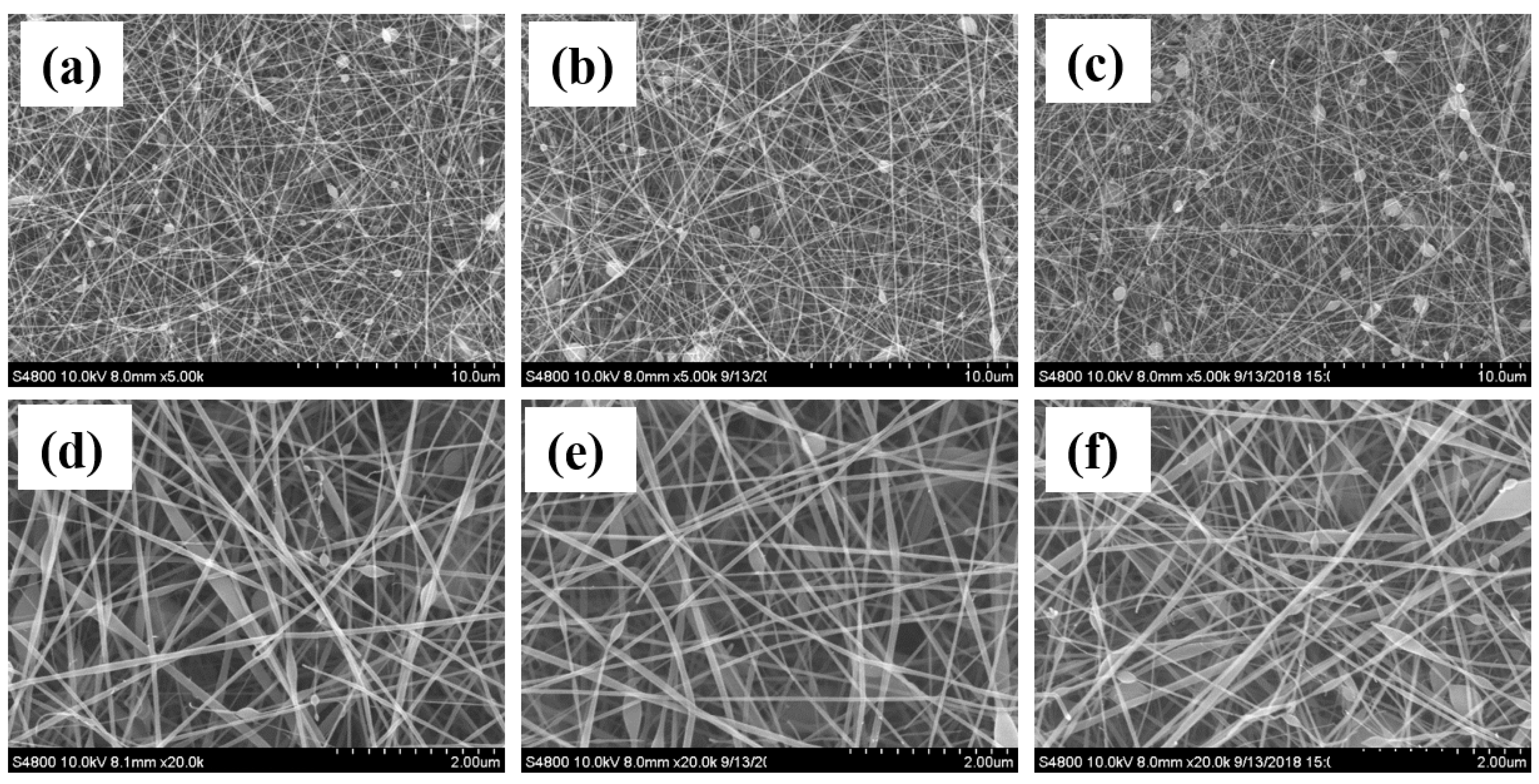
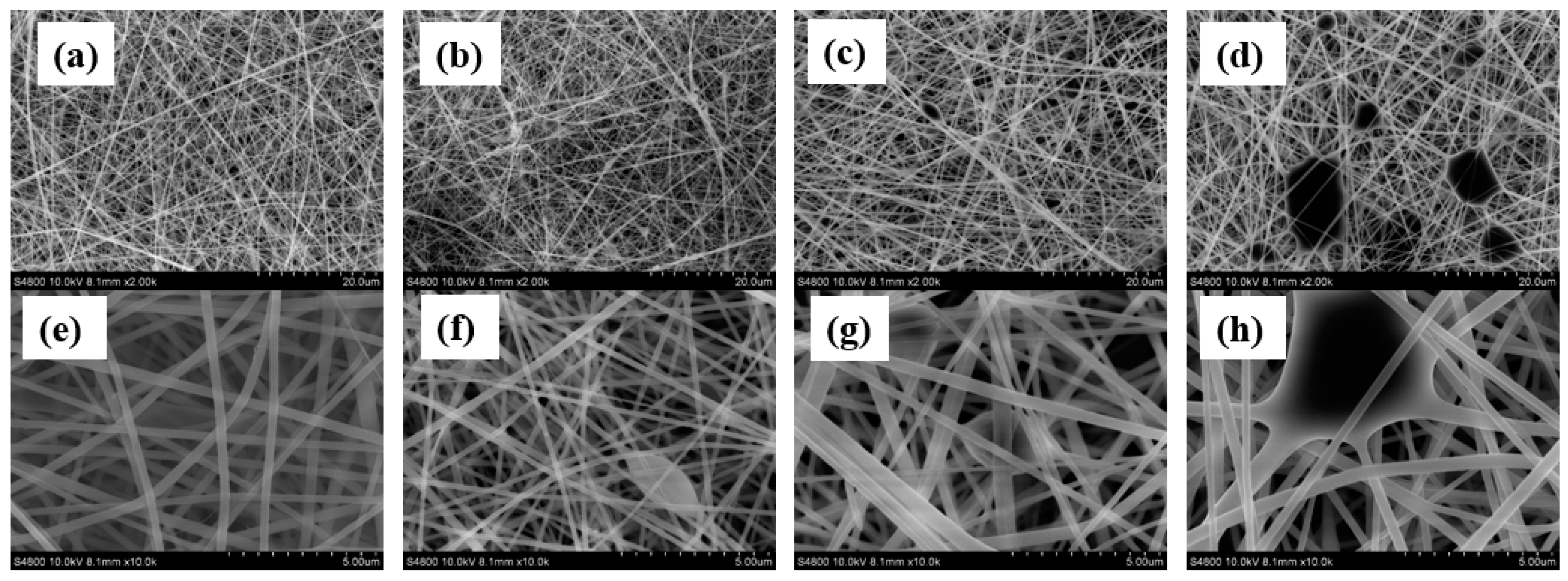
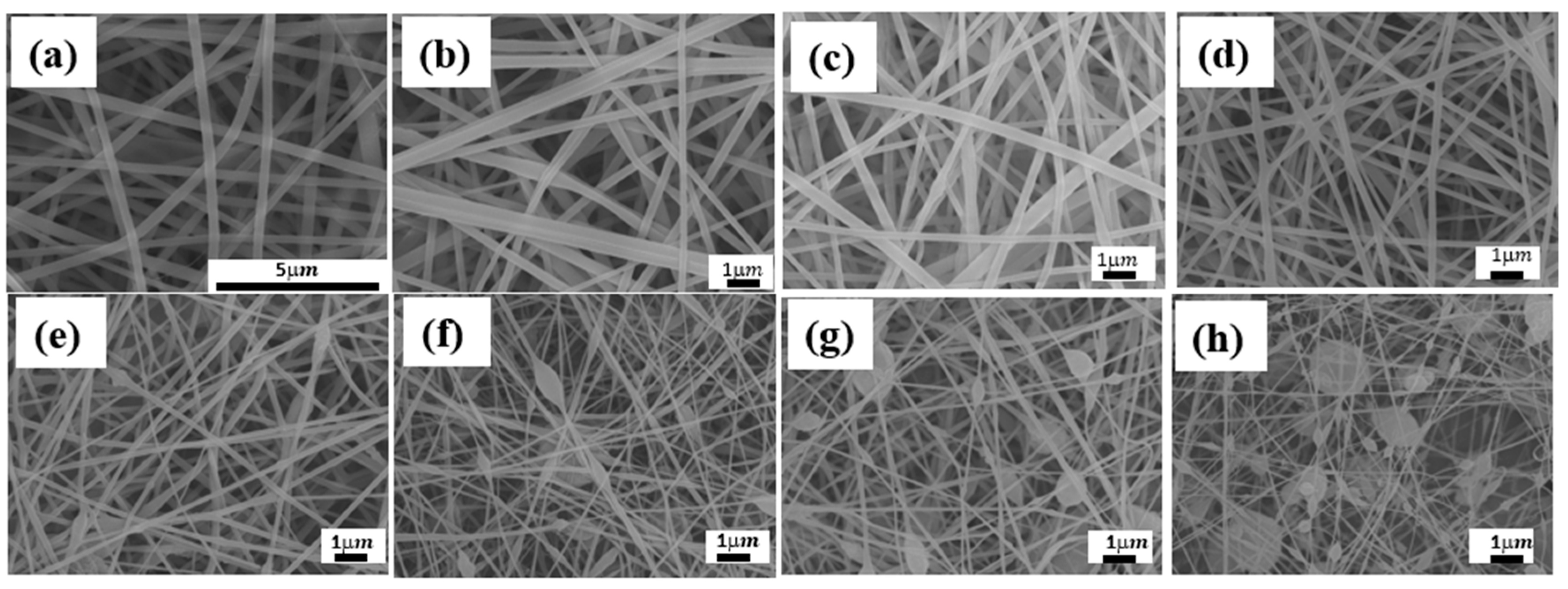
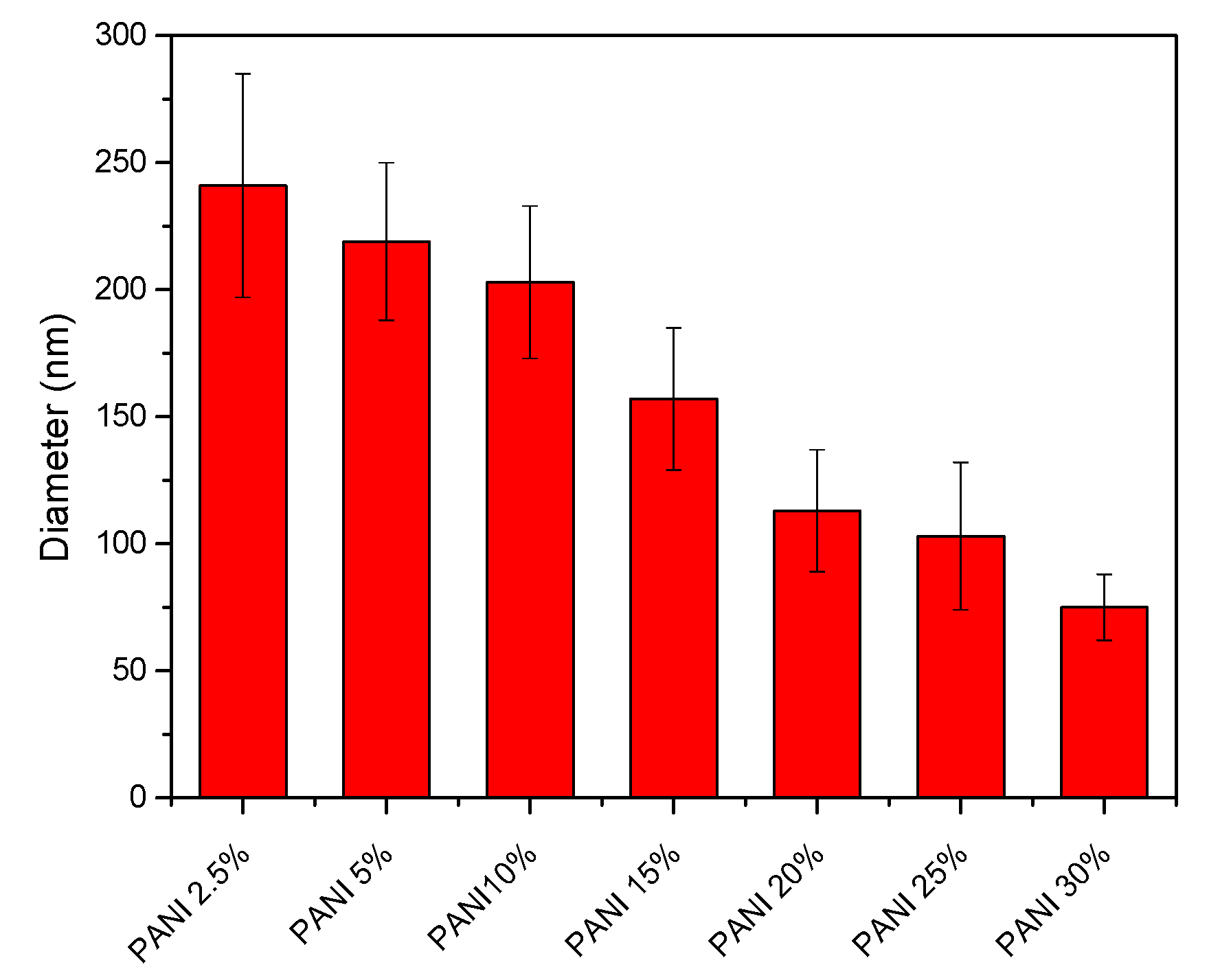

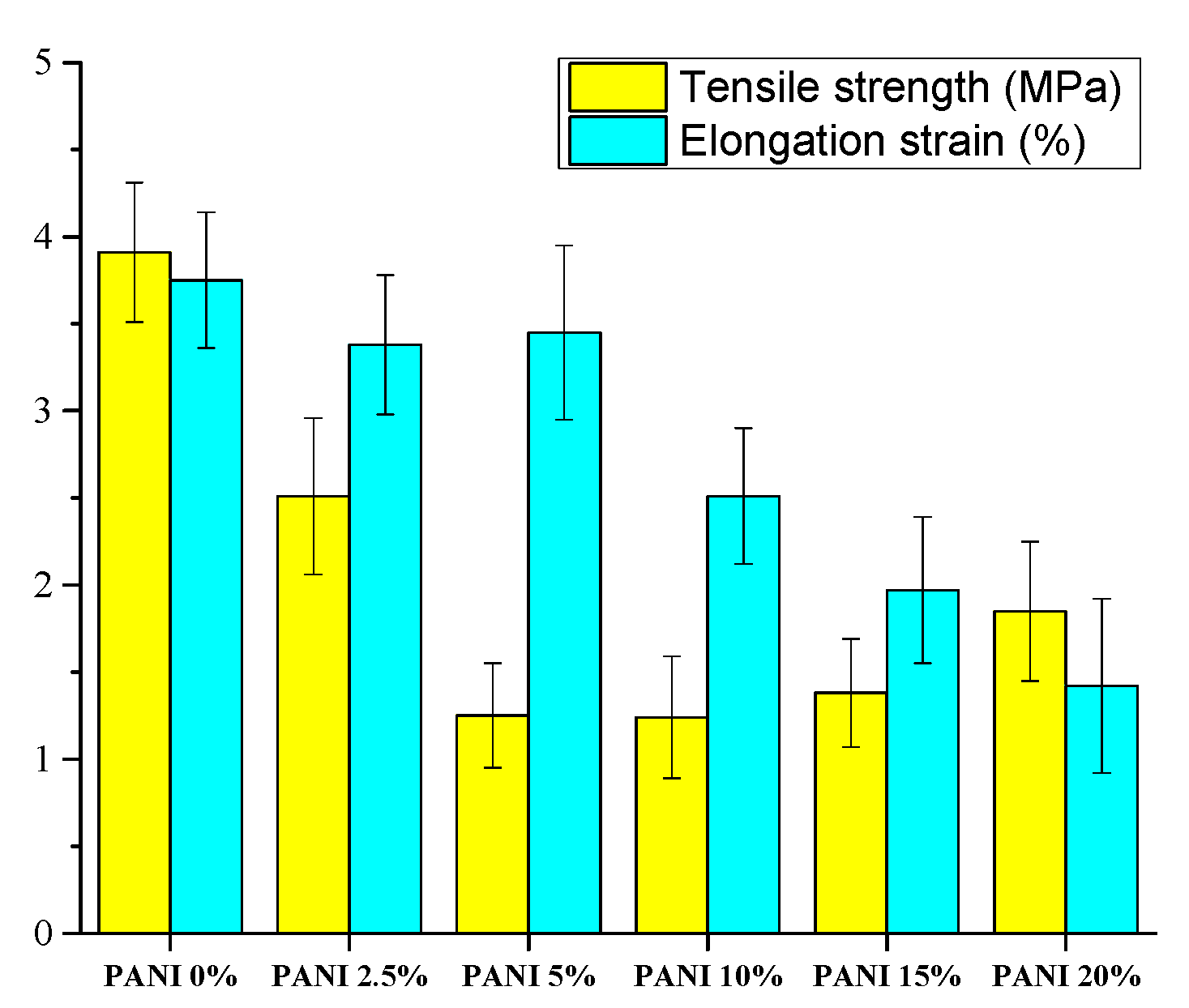
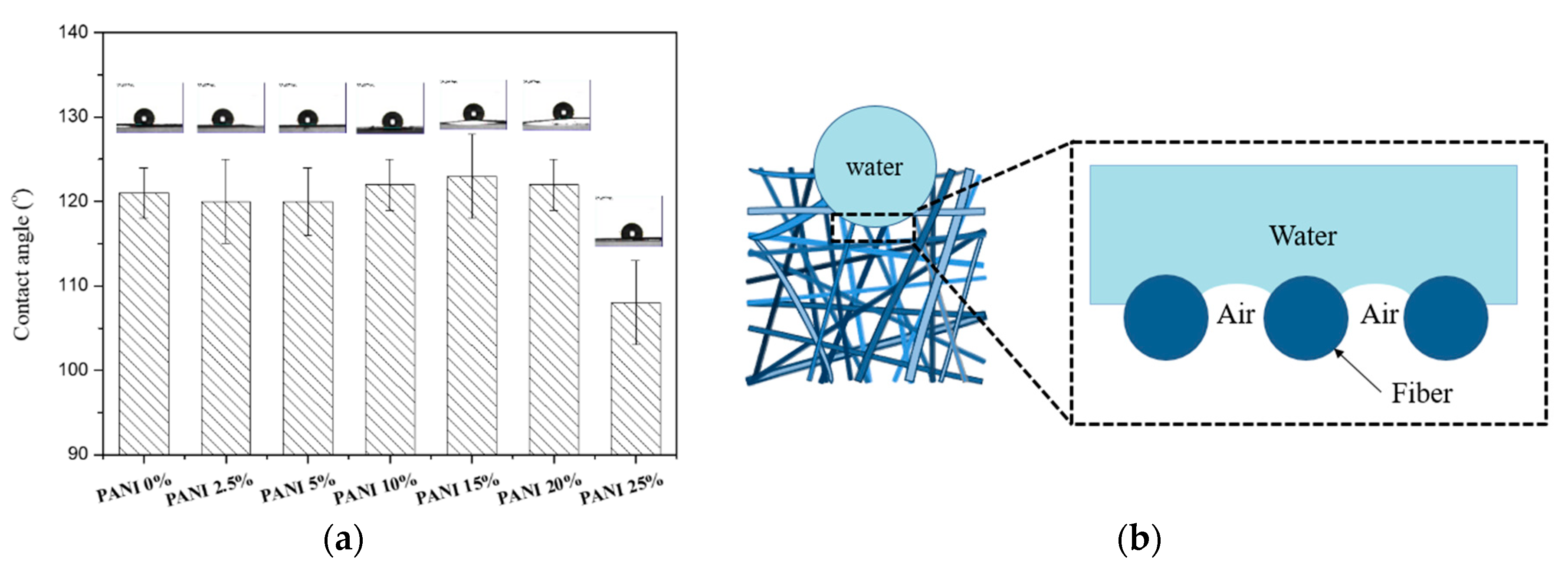
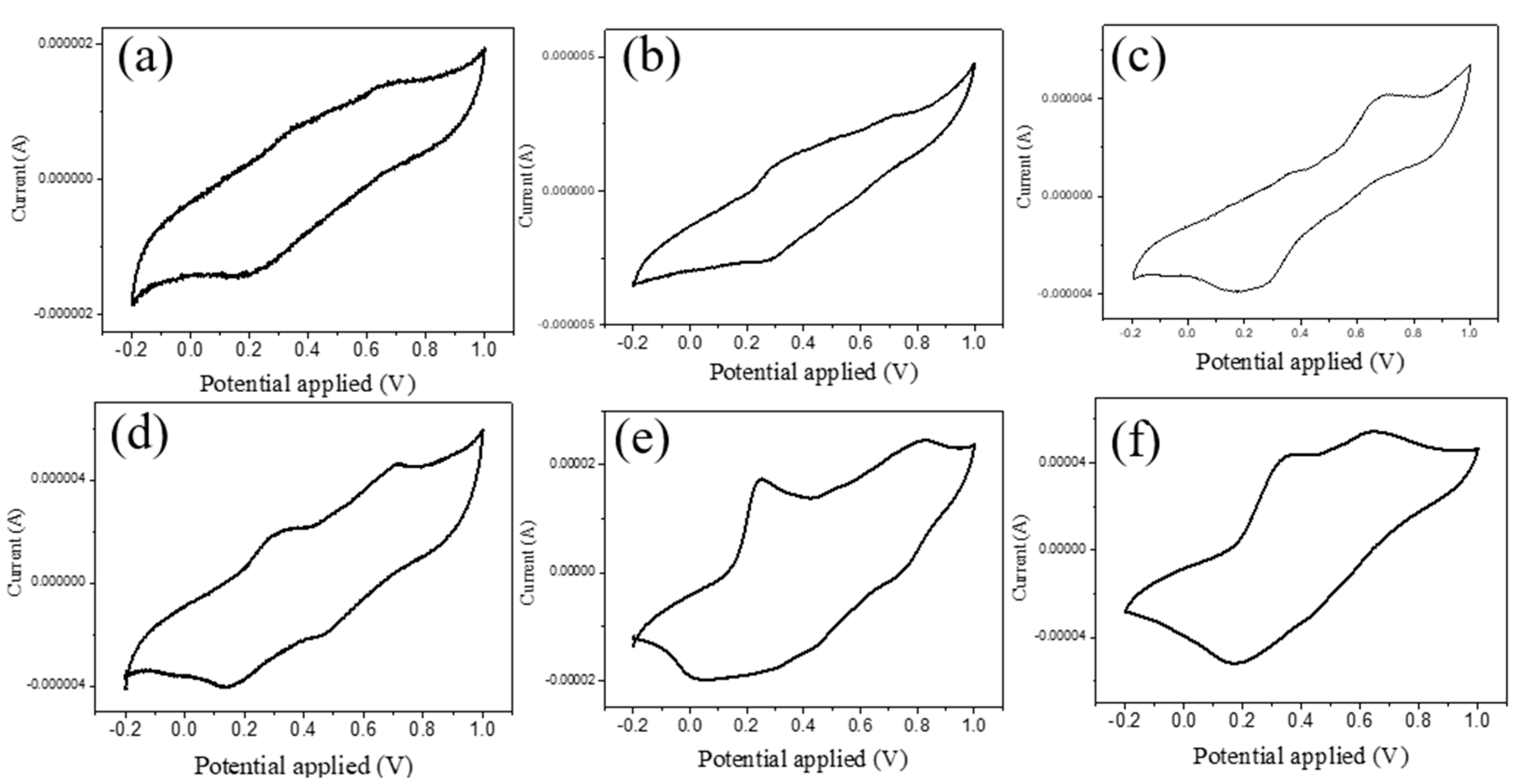


| PANI (%) | 0% | 2.5% | 5% | 10% | 15% | 20% | 25% | 30% |
|---|---|---|---|---|---|---|---|---|
| Formic Acid (g) | 9 | 9 | 9 | 9 | 9 | 9 | 9 | 9 |
| Silk Fibroin (g) | 1 | 0.975 | 0.95 | 0.9 | 0.85 | 0.8 | 0.75 | 0.7 |
| PANI (g) | 0 | 0.025 | 0.05 | 0.1 | 0.15 | 0.2 | 0.25 | 0.3 |
| PANI 2.5% | PANI 5% | PANI 10% | PANI 15% | PANI 20% | PANI 25% | PANI 30% | |
|---|---|---|---|---|---|---|---|
| Porosity | 75 ± 7.1% | 74 ± 8.3% | 73 ± 6.2% | 71 ± 6.8% | 67 ± 5.9% | 64 ± 6.4% | 55 ± 7.5% |
© 2020 by the authors. Licensee MDPI, Basel, Switzerland. This article is an open access article distributed under the terms and conditions of the Creative Commons Attribution (CC BY) license (http://creativecommons.org/licenses/by/4.0/).
Share and Cite
Chen, C.-Y.; Huang, S.Y.; Wan, H.-Y.; Chen, Y.-T.; Yu, S.-K.; Wu, H.-C.; Yang, T.-I. Electrospun Hydrophobic Polyaniline/Silk Fibroin Electrochromic Nanofibers with Low Electrical Resistance. Polymers 2020, 12, 2102. https://doi.org/10.3390/polym12092102
Chen C-Y, Huang SY, Wan H-Y, Chen Y-T, Yu S-K, Wu H-C, Yang T-I. Electrospun Hydrophobic Polyaniline/Silk Fibroin Electrochromic Nanofibers with Low Electrical Resistance. Polymers. 2020; 12(9):2102. https://doi.org/10.3390/polym12092102
Chicago/Turabian StyleChen, Chun-Yu, Szu Ying Huang, Hung-Yu Wan, Yi-Ting Chen, Sheng-Ka Yu, Hsuan-Chen Wu, and Ta-I Yang. 2020. "Electrospun Hydrophobic Polyaniline/Silk Fibroin Electrochromic Nanofibers with Low Electrical Resistance" Polymers 12, no. 9: 2102. https://doi.org/10.3390/polym12092102
APA StyleChen, C.-Y., Huang, S. Y., Wan, H.-Y., Chen, Y.-T., Yu, S.-K., Wu, H.-C., & Yang, T.-I. (2020). Electrospun Hydrophobic Polyaniline/Silk Fibroin Electrochromic Nanofibers with Low Electrical Resistance. Polymers, 12(9), 2102. https://doi.org/10.3390/polym12092102





